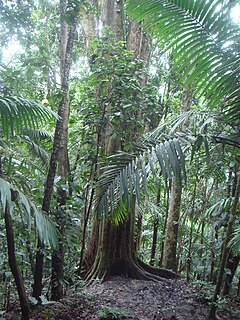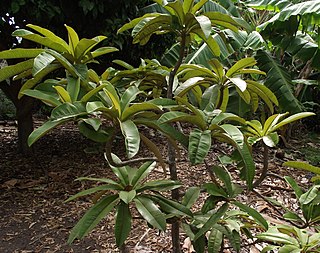
Manilkara bidentata is a species of Manilkara native to a large area of northern South America, Central America and the Caribbean. Common names include bulletwood, balatá, ausubo, massaranduba, and (ambiguously) "cow-tree".

Manilkara bella is a species of flowering plant in the family Sapotaceae. It is endemic to Brazil. It is endangered by overexploitation for timber and loss of habitat.
Manilkara cavalcantei is a species of plant in the family Sapotaceae. It is endemic to Brazil, where it is threatened by habitat loss.

Manilkara dardanoi is a tree species in the sapodilla family. It is endemic to Brazil, and only found in a small portion of Pernambuco. Here it grows in forests mostly along the coast, or elsewhere deeper inland where there is old secondary forest. Its natural habitat is gradually disappearing as forest is felled and land is cleared for human settlement.
Manilkara decrescens is a species of plant in the family Sapotaceae. It is endemic to Brazil, and is threatened by habitat loss.
Manilkara elata, also called the cow tree, is a species of plant in the family Sapotaceae. It is Endemic to the Amazon region in Brazil, where it is endangered by habitat loss.
Manilkara excelsa is a species of plant in the family Sapotaceae. It is endemic to Brazil, and threatened by habitat loss.
Manilkara excisa is an endangered species of tall tree in the sapodilla family. It is endemic to the extremely steep, forested limestone hills of Trelawny, Cockpit Country and St. James parishes in Jamaica, where, although it is highly prized for its wood, it is threatened by habitat loss.
Manilkara gonavensis is a tree species in the sapodilla family, found nowhere else but Haiti. It has only ever been collected one time for study, when the type specimen was taken. This was in the early 20th century, before 1929, which is the year it was described. Consequently, very little is known about M. gonavensis, and further study is needed. The specimen was taken from Haiti's Gonâve Island, which is reflected in the choice of its specific epithet.
Manilkara kanosiensis is a species of tree in the sapodilla family. It is thinly dispersed in low-lying rainforests over a large range, from the Maluku Islands of Indonesia to the Bismarck Archipelago of Papua New Guinea. It is endangered by the furious pace of logging in its native habitat, where it is felled as timber.

Manilkara longifolia, commonly known as masseranduba, is a species of plant in the family Sapotaceae. It is endemic to Brazil, where it is threatened by habitat loss.
Manilkara maxima is a species of plant in the family Sapotaceae. It is endemic to Brazil, where it is threatened by habitat loss.
Manilkara multifida is a species of plant in the family Sapotaceae.
Manilkara nicholsonii is a species of plant in the family Sapotaceae. It is endemic to South Africa (Natal), and is threatened by habitat loss.
Manilkara paraensis is a species of plant in the family Sapotaceae. It is endemic to Brazil, where it is threatened by habitat loss.
Manilkara pleeana, the zapote de costa, is a species of plant in the family Sapotaceae. It is endemic to Puerto Rico.
Manilkara rufula is a species of tree in the Sapodilla family. It is endemic to the northeastern submontane forests of Bahia, Sergipe, Pernambuco, Paraíba, Ceará and Piauí states of Brazil. Although this species exists in many places, where it occurs it is either not numerous, or its numbers are declining due to loss of habitat.
Manilkara spectabilis, or bully tree, is a little-understood, critically endangered species of tree in the sapodilla family. It has only ever been collected for botanical study once, from a single site near Limón in the Atlantic coastal forests of Costa Rica. It is believed to be endemic to this lowland region, the rainforests of which, though once unbroken, are now honeycombed by ongoing logging operations.
Manilkara subsericea is a species of plant in the family Sapotaceae. It is endemic to Brazil, and threatened by habitat loss.
Manilkara valenzuelana is a species of tree or tall shrub in the Sapodilla family. It is found in coastal and subcoastal semi-deciduous forests of Cuba, the Dominican Republic, Haiti, and possibly Puerto Rico. Its habitat has been declining rapidly under pressure from charcoal makers, logging, and the clearing of forest for human habitation.




